

Part Three
Section One - Keys and Tonality; Major Scales and Key Signatures
Keys and Tonality
1. In Exercises 296 to 306 of the last section you may have noticed that although each melody was repeated using a different set of notes, the melody still sounded fine and intact. Furthermore, when a sharp (or sharps) or flat (or flats) appeared it did so consistently. For example, the tune America in the version written in the Treble Clef a sharp was used for each occurrence of the note F, whereas, in the version written in the Bass Clef no sharps or flats appeared.
America - Written with F sharps
America - Written using no sharps or flats
In musical parlance, America was written in two different major keys. To best illustrate the concept of key, suppose we take the first four bars of a very familiar and simple melody by Mozart, Ah, Vous Dirai-Je, Maman 1 :
1. Slightly altered, this tune is better known as "Twinkle, Twinkle, Little Star."
Play through the melody a few times and notice how final and satisfying the final note C feels. (Although Mozart's melody continues beyond the four bars illustrated, this small portion is enough to illustrate the concept of key.)
Now, if we were to change the last note of Mozart's melody to an A or a B, the feeling of finality and satisfaction quickly disappears, leaving us hanging and expecting something more, a kind of resolution if you will. Play through the two versions below and hear this for yourself.


Neither altered version seems as satisfying to the ear as Mozart's original version, does it? If you wish, try inserting other notes as the final note. Your search will end when C is the final note because it is the only note that produces any completeness for this melody. This phenomenon is called tonality, and is the basis for the concept of key. Tonality is analogous to gravity: "What goes up must come down," Musically, there is always one note that predominates in a given song or composition. That note is called the tonal center, or key center, and all other notes gravitate towards it. Since the note to which all other notes gravitate is C, Mozart's melody is said to be written in the key of C.
For an illustration of a song written in another key, let's take "Clementine."
Clementine
Were we to similarly experiment with the last note of Clementine's melody, we would soon find that no note would satisfy the ear quite as much as F. Therefore, the tonal center or key of this melody is F. What, however, causes this shift in key? Why doesn't the note C work in this case? For the answer to these questions we must turn to scales and their structure. There are two basic types of scales, major and minor. First, we will concentrate on the major scale.
Tetrachords and the Major Scale
2. The sound of the major scale is familiar to everyone. We even used one as an exercise in the previous section -- the C major scale -- a scale that consists of only white keys from C to C. Also in the previous section, a scale was broadly defined as "a series of notes in successive (alphabetical) order of varying orders of whole-steps and half-steps." More specifically, a scale consists of eight successive notes in alphabetical order, or an octave. Since the C major scale is the easiest major scale to understand because it uses no sharps or flats, we will use it as our prototype. A major scale, beginning and ending on C, consists of the following order of whole-steps and half-steps:
Whole-step -- whole-step -- half-step -- whole-step -- whole-step -- whole-step -- half-step.
Let's examine this structure with notes written in the Treble Clef:

• This structure (sequence) of whole-steps and half-steps remains the same for all major scales.
A simple way to remember the structure of a major scale is to reduce it to its structural element, the tetrachord. The structure of a tetrachord is:
Whole-step -- Whole-step -- Half-step.
The first tetrachord of the C major scale is:

The second tetrachord starts on G -- up a whole-step from the last note of the first tetrachord:

Finally, when the two tetrachords are combined (and separated by a whole-step), a major scale is formed.

• The notes that make up the C major scale are the basic ingredients of any song or composition written in the key of C major.
Armed with this knowledge, let's answer the questions asked earlier about the melody of Clementine: "What, however, causes this shift in key (from C to F)?" "Why doesn't the note C work in this case?" First, play Clementine again, feeling the strength of the final note F.
Now play it again, this time replacing the B flats with B naturals (*):

Does the melody sound strange without B flats? Does it sound as satisfying as it did when using B flats? Hopefully you answered "yes" to the first question and "no" to the second question. To find out why B flat is so indispensible in a song whose tonal or key center is F we must construct a major scale from F to F.
Our first step is to write a basic scale using only natural notes from F to F:

Now play through this scale; notice how the B natural sounds out of place, even awkward.

The reason is that the intervals between A and B and B and C have been reversed. The proper sequence of intervals between these degrees 2 of the scale should be Half-step, Whole step. To fix this problem, let's create our first tetrachord according to the pattern already given:

2. Each note or step of a scale is also called a degree, or scale degree.
By inserting a B flat we have caused the former sequence of Whole-step -- Whole-step -- Whole-step to conform to the correct sequence: Whole-step -- Whole-step -- Half-step.
When we create our second tetrachord, we find no alterations are necessary

because the B flat also gave us the Whole-step that divides the two tetrachords, as follows:

So, as you can see, an F major scale includes as an important ingredient, B flat. Play it and notice the dramatic difference yourself.
• An important item to keep in mind about melodies is that they often do not include every note of the scale they are based on. In Mozart's melody, for example, he used only the following degrees of the C major scale:

Placed in the following order and with the following rhythms, Mozart composed the tune so familiar to all of us:
Likewise, Clementine uses only the following scale degrees in its tune:3

3. Notes such as the Middle C and the E in the next to last measure do not fall within the range of the F major scale used to illustrate the scale degrees. Therefore, for illustration purposes, they were brought within the range of the scale as indicated by the asterisks.
Key Signatures
3. Until now, each melody included the proper accidentals next to those notes that needed to be altered according to the scale upon which it was based. The system of musical notation, however, has a shorthand device for letting us know which scale a melody is based on -- therefore what key it is in -- known as a key signature.
Key signatures comprise the sharps or flats used in a given scale,4 and are placed at the beginning of each line of music -- in their proper space or on their proper line -- just after the clef and just before the time signature. 5 Let's rewrite "America" using a key signature instead of placing a sharp sign next to each F in the melody. The key signature below is for the Key of G Major.

4. Sharps and flats are never mixed in a key signature.
5.The time signature need only appear on the first line of music or until changed.
Notice how the sharp sign was placed on the top line of the treble clef, the line where the note F is located. Having done this, it is understood that all F's -- in whatever range they appear -- are automatically sharped unless canceled by another sign such as a natural sign or a flat.
Let's place "America" in the Bass Clef using the same key signature as before -- G Major:

Notice how the sharp in the key signature has been moved down one line so it is placed on the line where F is located in the Bass Clef. Again, although the written F's (as indicated by the asterisks) are not those located on the line where the sharp in the key signature is placed, it is understood that all F's are to be sharped, wherever they are located.
Let's take another look at Clementine, this time written with the key signature of F Major instead of placing a flat next to each B. Again, it is understood that all B's are automatically to be flatted.

As you can see, scales, keys, and key signatures are very closely related, so much so that the following observations can be made:
a) The key of a song or composition derives its name from the scale upon which it is based: i.e., a song in C major is based upon the notes of the C Major Scale.
b) A key signature lists and visually represents those sharps or flats that are necessary for a given scale. In effect, the sharps or flats of that scale are extracted from the scale and placed at the beginning of each line of music.
The Circle of Fifths 6
4. Below is a diagram of the Circle of Fifths, showing all thirteen key signatures and major scales (listed outside the circle) and the number of sharps or flats in their key signatures (listed inside the circle). It is called the Circle of Fifths because, as we proceed in clockwise motion from the top of the circle (starting at C), each new key is exactly five letter names up from the preceding key: For example, C -- d -- e -- f -- G; G -- a -- b -- c -- D. The keys of F# Major (six sharps) and Gb Major (six flats) meet at the bottom because they are, for all practical purposes, the same key, as are their respective scales. Once F# Major has been enharmonically spelled as Gb Major, the process continues until we reach C Major again.
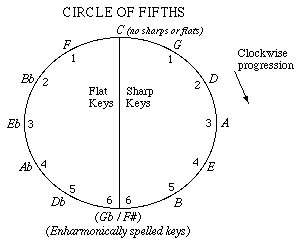
The process can be reversed by traveling counterclockwise from C Major, proceeding down by fifths (five letter names down: C -- b -- a -- g -- F) until we reach the bottom of the circle and the key of Gb Major is enharmonically spelled as F# Major. From there, we proceed in fifths until we reach C Major at the top of the circle.
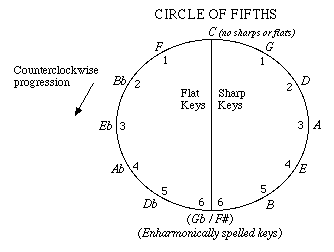
6. A fifth is the distance (interval) of five notes in stepwise progress up or down a scale from any note. They are generally counted by letter names. See Part Two, Section Six for a detailed discussion of intervals.
Order and Placement of Accidentals in Sharp Key Signatures
5. The process of adding accidentals to key signatures is also governed by the fifth. As you know the first sharp is F#, used to identify G Major. 7 Below are both the F# placed in the key signature and the written note F# placed in the same location on the staff in both clefs.
• The rule that accidentals placed in a key signature affect all notes of the same name -- in all ranges -- always applies.

7. It also identifies a minor key and scale, as do all key signatures. For a detailed discussion of minor key signatures and minor scales see the next section.
The next key, D Major, has two sharps: F# and C#. (C# is five letter names up from F#.)
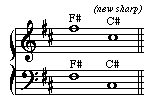
• Although the placement of the second sharp, C#, is placed four steps below the first sharp, F#, a quick calculation would show that traveling up five steps (letter names) in a scale produces a note of the same name as traveling down four steps. These traditional placements of accidentals in a key signature are a practical attempt to keep all accidentals on the staff, thereby avoiding the use of leger lines.
The key of A Major has three sharps: F#, C#, and G#.
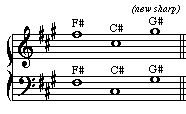
• Notice the cumulative effect when adding accidentals to a key signature: Each new accidental is added to those previous accidentals. This holds true for all key signatures, whether sharp keys or flat keys.
The key of E Major has four sharps: F#, C#, G#. and D#.

The key of B Major has five sharps: F#, C#, G#. D#, and A#.
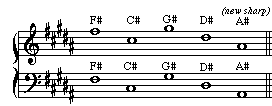
The key of F# Major has six sharps: F#, C#, G#. D#, A#. and E#.
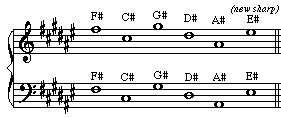
An Easy Way To Identify Any Sharp Major Key
6. A quick and easy way to identify any major key by its key signature is to identify the last sharp (the newest sharp, furthest to the right) and go up one half-step; that will be the major key. Here are a few examples:
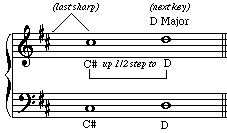
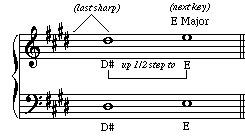
• Of course, for the key of G Major, since there is only one sharp -- F# -- it is treated as the last sharp. Therefore, going up one half-step from F# brings us to G, our key.
Order and Placement of Accidentals in Flat Key Signatures
7. Flats are placed in key signatures in the opposite order as sharps -- each new flat is five letter names down from the previous flat. As you already know, the first flat is Bb, which identifies the key of F Major.8

8. A Bb in the key signature also identifies a minor key which will be discussed in further detail in the next section.
The next key, Bb Major, has two flats: Bb and Eb. (Eb is five letter names down from Bb.)
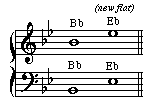
The key of Eb Major has three flats: Bb, Eb, and Ab.
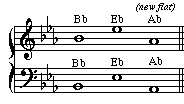
• Notice the cumulative effect when adding accidentals to flat key signatures also: Each new accidental is added to those previous accidentals.
The key of Ab Major has four flats: Bb, Eb, Ab. and Db.
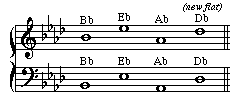
The key of Db Major has five flats: Bb, Eb, Ab. Db, and Gb.
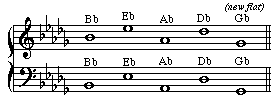
The key of Gb Major has six flats: Bb, Eb, Ab, Db, Gb, and Cb.

An Easy Way To Identify Any Flat Major Key
8. A simple way to identify any major flat key is to locate and name the next to last flat in the key signature. Of course, the key of F Major must be memorized since it has only one flat in its key signature. For the other flat keys, however, the above technique will always work. Here are a few examples:

All The Major Key Signatures and Their Scales
9. There are thirteen key signatures; for your reference they are described below, this time accompanied by their major scales with the appropriate accidentals inserted.
• Go through the complete list of major scales below and locate the whole-steps and half-steps in each scale; if necessary keep the structural pattern in front of you as a guide.
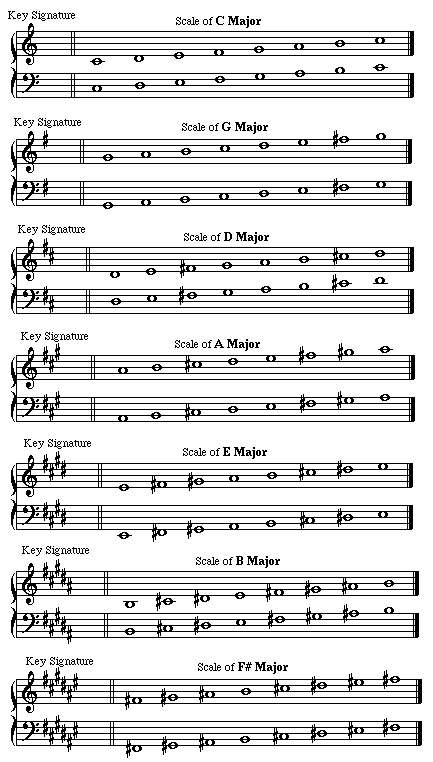
Now the flat keys and their major scales:
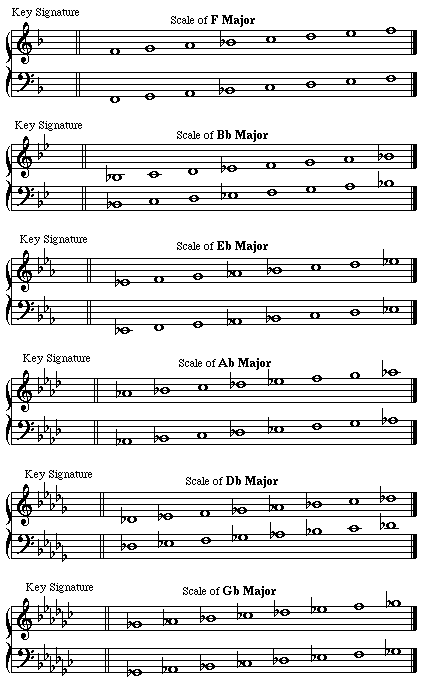
1. Tonality is the basis for the concept of key in which one note predominates in a given song or composition.
2. A tonal center or key center is defined as the predominant note to which all other notes of the scale gravitate.
3. A tetrachord is a series of four notes in stepwise progression with the following structure of whole-steps and half-steps:

4. A major scale is a series of eight notes (spanning an octave) in stepwise progression. It is composed of two consecutive tetrachords, divided by a whole- step, structured in the following pattern of whole-steps and half-steps:

5. A key signature is a shorthand device consisting of accidentals placed at the beginning of each line of music that tells us which note or notes are to be sharped or flatted, according to the scale upon which the notes of a song or composition are based. They are placed just after the clef and just before the time signature.
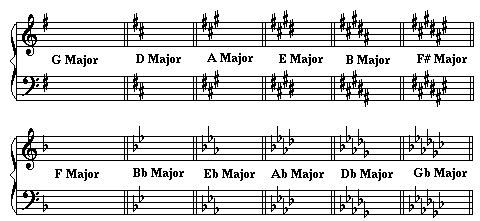
6. Accidentals in a key signature affect all notes of the same name as those accidentals -- in all ranges -- unless canceled by another sign such as a natural sign or other accidental.
7. Sharps and flats are never mixed in a key signature.
8. The order of key signatures is governed by the interval of the fifth (five letter names) as outlined in the Circle of Fifths:

9. Accidentals in a key signature are added cumulatively as in the following examples:

10. A quick and easy way to identify any major key by its key signature is to identify the last sharp (the newest sharp, furthest to the right) and go up one half-step.

11. A simple way to identify any major flat key is to locate and name the next to last flat in the key signature; the name of that flat will be the name of the key.

• Stop and Review !
This material is copyrighted © 1992 by Whitco Press. All Rights Reserved International Copyright Secured
This site and its entire contents © 2003 by Richard White (Whitco Press)